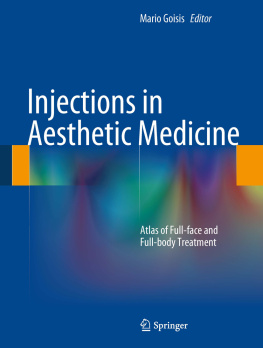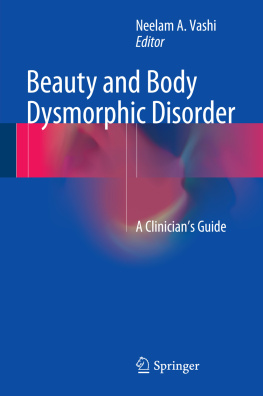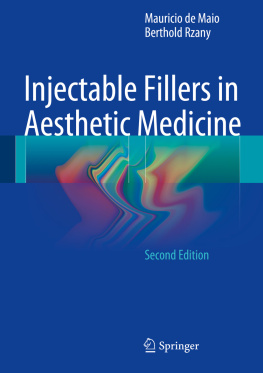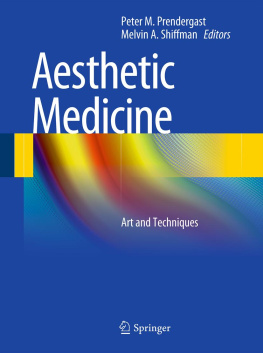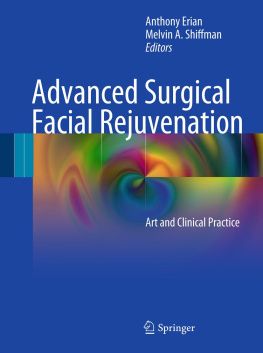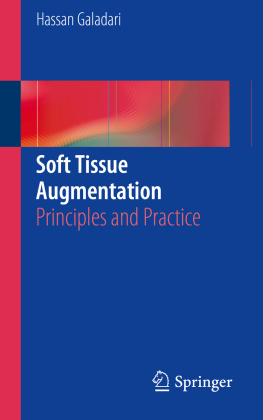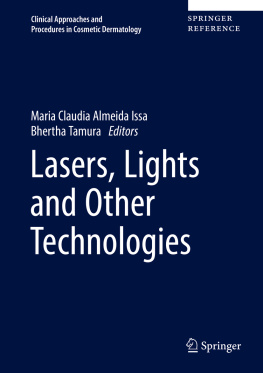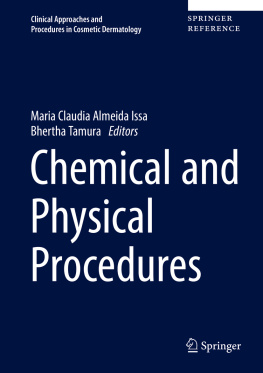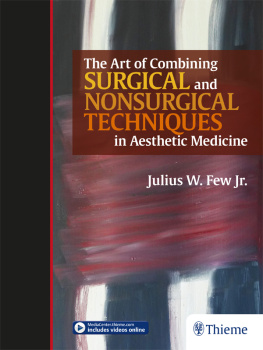1.1 Permanent Fillers
Doris Ali Youssef
The pursuit of beauty and the effort to reverse the effects of ageing dates back to many centuries. Facial volume depletion and facial rhytids are a natural and inevitable part of ageing. Over the last 100 years, various attempts to restore volume to the face with the use of injectable devices have been described.
The prologue to this story must start with the development of the appropriate technology, namely the syringe. The hollow needle was invented in 1844 by Irish physician Francis Rynd [].
The fillers history begins in 1830, when a German chemist, Baron Karl Ludwig von Reichenbach, discovered a material created by the dry distillation of beech-wood tar. He noted this substance to be very unreactive and named it paraffin, from the Latin parum (barely) and affinis (affinity). The first reported use of a material injected into the body for cosmetic purposes was by Robert Gersuny (18441924) [], who described inflammation, infection, embolism, and yellowish skin plaques at the site of the injection. In the following years, the term paraffinoma was used to describe the granulomatous foreign-body reaction that developed as a result of paraffin injection.
The most famous account of the complications of paraffin injection was that of the Duchess of Marlborough [] Over time, the fatty tissue calcifies and develops hyaline sclerosis, producing yellowish skin nodules. These lesions can become infected or fistulize. Because the paraffin is inert, it remains completely unchanged in the body and can migrate through the fatty tissue, stopped only by fascial planes.
Over the subsequent years, similar injectables such as vegetable oil, mineral oil, lanolin and beeswax have been used for cosmetic injections but were abandoned due to undesirable complications including migration, granuloma formation and scarring. A tragic example of such injections was described in the London Daily Telegraph (November 11, 2008). A Korean woman received silicone injections from a physician who also gave her syringes to self-administer. After she ran out of silicone, she substituted cooking oil for self-injection and ultimately became severely disfigured.
1.1.1 Liquid Silicone
In the 1960s, liquid silicone injection became a popular cosmetic treatment []. Like paraffin, silicone is an inert, clear, oily substance that is easily injected and, unfortunately, had similar disastrous sequelae. Silicone, a polymer of dimethylsiloxanes, was first used in Japan during the 1940s for breast augmentation. This practice spread to the United States (California, Texas and Nevada), in 1965, Dow Corning developed a purified silicone that could be used for injection, called MDX44011. In subsequent years, it was noted that the injected silicone would migrate and fistulize, and it had resulted in several deaths. Some patients with severe complications required mastectomies. Because of the complications encountered in the Las Vegas showgirls injected with silicone, Nevada was the first state to ban the use of injectable silicone. In 1964, Weiner coined the term siliconoma to describe the soft tissue granuloma that developed from injected silicone. These disfiguring inflammatory responses could sometimes be seen decades after silicone had been injected. Although medical-grade silicone was also used to treat facial wrinkles and augment the lips, the U.S. Food and Drug Administration (FDA) considered it an investigational device and never approved silicone for cosmetic use. In 1964, the FDA regulated the use of injectable silicone as a drug, and the Medical Device Amendments of 1976 restricted the use of silicone as a device. After reports of the sequelae of injected silicone, in 1979, the FDA and the American Medical Association condemned the use of injectable liquid silicone. Although today medical-grade silicone is available for ophthalmic use in the treatment of detached retinas, its cosmetic use is considered illegal in some states. In spite of the problems encountered with injectable liquid silicone, silicone injections are still performed in Europe, Canada, Mexico and by some physicians in the United States. Since 1994, two medical-grade silicone products were available to treat detached retinas, and use of these products cosmetically is considered off-label. Even though the use of injectable silicone for cosmetic purposes is federally banned and illegal in some states, some physicians feel that in the hands of experienced surgeons, injections can be extremely efficacious. They purport the microdroplet injection technique using a small needle and deep injection into the dermis and subcutaneous fat. These injections are performed in multiple treatments over 1- to 3-month intervals. The authors strongly suggest not to use liquid silicon and to consider this use illegal.
1.2 Collagen
1.2.1 Heterologous Collagen
Giorgio Persichetti, Valentina Isgr
Bovine collagen has been the most widely used filler material in the early 2000s (See Table ). Three products have been manufactured and distributed by Inamed: Zyderm I, Zyderm II, and Zyplast. Inamed has been acquired by Allergan at the end of 2005. Allergan continued marketing these products until the end of 2010. In June 2008, Johnson & Johnson patented their own product, Evolence, derived from porcine collagen. The production of Evolence has been suddenly discontinued in November 2009.
Zyderm I corrected fine lines quite well, particularly fine perioral and crows-feet lines. Zyderm II, designed to correct average lines, offers an average duration of 36 months. Zyplast was designed to correct deep wrinkles in thick skin and to restore facial volume (lips and outline of the face). It generally lasted 612 months [].
Evolence has been recommended for the treatment of moderate to deep wrinkles, fold and lines, including hard-to-treat nasolabial folds.
Due to the possible allergic reactions concerning the use of heterologous collagen, a preliminary test was mandatory before injection.
A double test was recommended because positive reactions to treatment have been reported in 0.31.5 % of patients even after clinical selection and initial testing [].
Pons-Guiraud [] recommends the following protocol, which can take up to 7 weeks to complete. The first injection (0.1 mL) is given in the anterior aspect of the forearm, followed by a reading at 72 h. A positive reaction is characterized by a change in the contour of the injected implant, erythema, oedema, occasionally pruritus and, rarely, by an indurated papule or inflamed dermal nodule. All positive reactions contraindicate collagen injections. A second injection is given 15 days later, followed by readings 3 days and 4 weeks later. Any positive reaction to the test or double test contraindicates the collagen injection. If there is any doubt, bovine (ACACB) and human (ACACH) anticollagen antibodies must be measured.
Concerning complications, a study performed by Castrow and Krull [] on behalf of 316 practitioners, covering approximately 7,000 patients who demonstrated negative test results revealed a side-effect rate at the injection site of 1.5 %.

